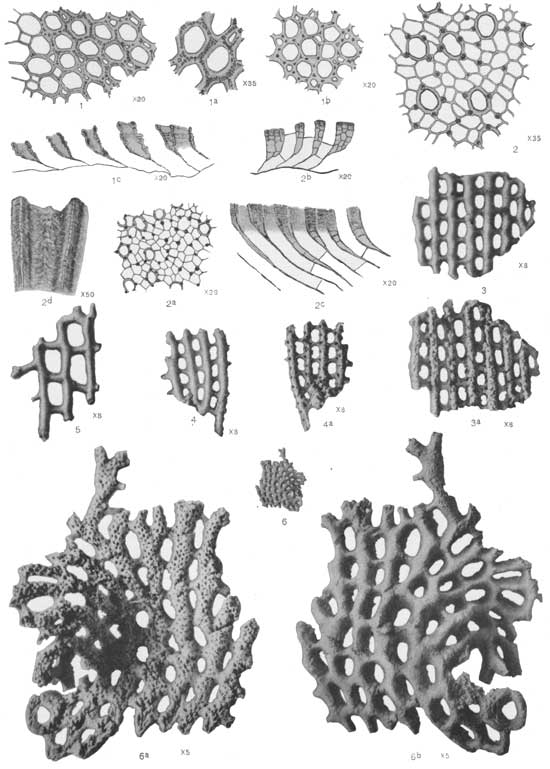
|
Geological Survey Professional Paper 58
The Guadalupian Fauna |
PLATES — PLATE XIX.
"DARK LIMESTONE," GUADALUPE MOUNTAINS
|
STENOPORA GRANULOSA n. sp. (p. 128). | |
| FIGS. 1 to 1c. |
The typical specimen. |
| 1. |
Tangential section, showing granular bands in walls, X 20. |
| 1a. |
Same, more highly magnified, X 35. |
| 1b. |
Tangential section, showing granular acanthopores, X 20. |
| 1c. |
Vertical section, showing the irregular moniliform character of the walls and the absence of tabulae, X 20. "Dark limestone," Pine Spring (station 2930). |
|
LEIOCLEMA SHUMARDI n. sp. (p. 131). | |
| FIGS. 2 to 2d. |
The typical specimen. |
| 2. |
Tangential section, showing zooecia, mesopores, and acanthopores, X 35. |
| 2a. |
Same, X 20. |
| 2b. |
Vertical section through spreading base, showing tabulated mesopores, X 20. |
| 2c. |
Vertical section of a branch, showing the thickened tissue on the walls in the mature region which has obscured the tabulated mesopores, X 20. |
| 2d. |
Vertical section of walls, showing tabulated acanthopores, X 50. "Dark limestone," Pine Spring (station 2930). |
|
FENESTELLA HILLI n. sp. (p. 134). | |
| FIGS. 3 and 3a. |
A silicified specimen. |
| 3. |
Nonporiferous side, X 8. |
| 3a. |
Poriferous side, X 8. "Dark limestone," Guadalupe Point (station 3762e). |
|
FENESTELLA SPINULOSA Condra? (p. 137). | |
| FIGS. 4 and 4a. |
A silicified specimen resembling this species. |
| 4. |
Nonporiferous side, X 8. |
| 4a. |
Poriferous side, X 8. "Dark limestone," Pine Spring (station 2930). |
|
FENESTELLA GUADALUPENSIS n. sp. (p. 135). | |
| FIG. 5. |
A silicified specimen. |
| FIG. 5. |
Nonporiferous side, X 8. "Dark limestone," Pine Spring (station 2930). |
|
POLYPORA MEXICANA Prout? (p. 143). | |
| FIGS. 6 to 6b. |
A silicified specimen referred to this species. |
| 6. |
Nonporiferous side, natural size. |
| 6a. |
Poriferotis side, X 5. |
| 6b. |
Nonporiferous side, X 5. "Dark limestone," Guadalupe Point (station 3762e). |
 |
| Plate XIX. (click on image for a PDF version) |
| <<< Previous | <<< Contents >>> | Next >>> |
pp/58/plate19.htm
Last Updated: 05-Dec-2008